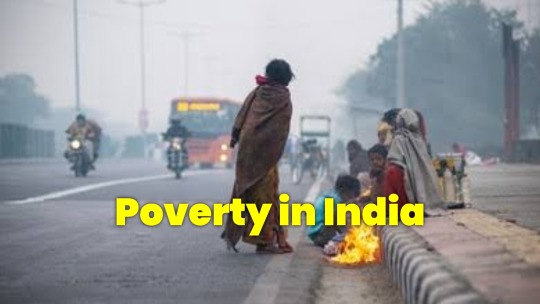#poverty in india
Text
भारत की 40 फीसदी संपत्ति 1 फीसदी लोगों के पास, 100 सालों में सबसे बदतर हुई स्थिति; रिपोर्ट
भारत की 40 फीसदी संपत्ति 1 फीसदी लोगों के पास, 100 सालों में सबसे बदतर हुई स्थिति; रिपोर्ट
Economic Inequality: देश में 2000 के दशक की शुरुआत से आर्थिक असमानता लगातार बढ़ती जा रही है. इसका खुलासा एक रिपोर्ट में हुआ है. 2022-23 में देश की सबसे अमीर एक प्रतिशत आबादी के पास 22.6 प्रतिशत आय पर कब्जा हो गया है.
जबकि भारत की पूरी संपत्ति का 40 प्रतिशत से अधिक हिस्सा देश के सिर्फ एक प्रतिशत अमीर लोगों के पास पहुंच गया है. रिपोर्ट ये भी कहा गया है कि 1922 से लेकर अब तक भारत में सबसे आर्थिक…

View On WordPress
#5 latest news headlines in English today#5 latest news of India Today#टॉप राइट न्यूज#ब्रेकिंग राइट न्यूज#राइट#राइट इंडिया#राइट न्यूज#राइट न्यूज इंडिया#राइट समाचार#हिंदी राइट न्यूज#Breaking News in India Today#Breaking news in India Today in English#breaking right news#economic inequality#Google News#Human rights news today#India wealth#international news#News Bangalore#News headlines#News Hindi#news india#news live#News Tamil#news today#News Today Live#People also search for#poverty in india#right#right news
0 notes
Text
How Bad is the Gap Between Rich and Poor in India?
India, with its vast population and diverse socioeconomic landscape, has long struggled with income inequality and the gap between the rich and poor. This issue has garnered significant attention both domestically and internationally, highlighting the pressing need for effective measures to address the disparities.
At one end of the spectrum, India is home to some of the wealthiest individuals…
View On WordPress
0 notes
Link
A small contribution can make a big difference in the lives of India's most vulnerable children so donate now!
#ngo in india#donate online to charity#online donate money#poverty in india#best ngo for children#donate for child health#donation for child care
0 notes
Text
ಹಸಿವಿನ ಸೂಚ್ಯಂಕದಲ್ಲಿ ಭಾರತಕ್ಕೆ 107ನೇ ಸ್ಥಾನ; ದೇಶದ ವರ್ಚಸ್ಸಿಗೆ ಮಸಿ ಬಳಿಯುವ ಪ್ರಯತ್ನ ಎಂದ ಸರ್ಕಾರ
ಹಸಿವಿನ ಸೂಚ್ಯಂಕದಲ್ಲಿ ಭಾರತಕ್ಕೆ 107ನೇ ಸ್ಥಾನ; ದೇಶದ ವರ್ಚಸ್ಸಿಗೆ ಮಸಿ ಬಳಿಯುವ ಪ್ರಯತ್ನ ಎಂದ ಸರ್ಕಾರ
ದೆಹಲಿ: ಜಾಗತಿಕ ಹಸಿವು ಸೂಚ್ಯಂಕ (Global Hunger Index – GHI) ಶನಿವಾರ (ಅ 15) ಬಿಡುಗಡೆ ಆಗಿದೆ. ಜಾಗತಿಕ ಹಸಿವು ಸೂಚ್ಯಂಕದಲ್ಲಿ ಭಾರತವು ಆರು ಸ್ಥಾನ ಕಡಿಮೆಯಾಗಿದೆ. ಈ ಸೂಚ್ಯಂಕಕ್ಕಾಗಿ ಪರಿಗಣಿಸಲಾಗಿದ್ದ 121 ದೇಶಗಳ ಪೈಕಿ ಭಾರತವು 107ನೇ ಸ್ಥಾನದಲ್ಲಿದೆ. ಈ ಸೂಚ್ಯಂಕವನ್ನು ನಿರಾಕರಿಸಿರುವ ಕೇಂದ್ರ ಸರ್ಕಾರವು, ‘ಇದು ತಪ್ಪು ಮಾಹಿತಿ ಮತ್ತು ವಿಶ್ಲೇಷಣೆಗಳನ್ನು ಒಳಗೊಂಡಿದೆ’ ಎಂದು ಅಭಿಪ್ರಾಯಪಟ್ಟಿದೆ.
‘ಕಳೆದ 22 ವರ್ಷಗಳಲ್ಲಿ (2000ರಿಂದ) ಭಾರತವು ಗಣನೀಯ ಪ್ರಗತಿ ಸಾಧಿಸಿದೆ. ಆದರೆ…
View On WordPress
0 notes
Text

#anti slavery#wage slavery#chattel slavery#slavery#unions#union strong#labor unions#union#class war#helluva boss#subway boss ingo#subway boss emmet#boss#poverty#workers rights#workers rise up#worker solidarity#workers solidarity#sex worker#horror moment customers attack worker over iphone 15 pro delay as new phone launch sparks buying frenzy across india#four workers killed after lift collapses in high rise building under construction in noida#workers of the world unite#ausgov#politas#auspol#tasgov#taspol#australia#fuck neoliberals#neoliberal capitalism
228 notes
·
View notes
Photo

Poverty reduction in India
A record 13.5 crore people moved out of multidimensional poverty between 2015-16 and 2019-21 as per NITI Aayog’s Report ‘National Multidimensional Poverty Index: A Progress Review 2023’.
by the.graphic.earth
157 notes
·
View notes
Text
[It is] true among the poor and oppressed today: never forget that more than 50 per cent of Indian women—a nation of more than 1.3 billion people—are currently suffering from anemia and malnutrition, due in no small part to local traditions where young women eat last, after the father, children, any men in the extended family, and finally older women. When the young woman is pregnant, malnutrition becomes especially severe and harms the fetus, further stunting the upcoming generation of one of the world's most important economies and, by far, the world's largest democracy. This won't be the last time I say this: humans are mammals. If we want to invest in humanity's future, we have to feed human mothers, and we have to feed them well. It would also be nice if we'd stop abusing and killing in women in general, but let's start with the food.
– Cat Bohannon (2023) Eve: How the Female Body Drove 200 Million Years of Human Evolution.
77 notes
·
View notes
Text
radfems, here's some all rounded perspective about prostitution, poverty, child trafficking (and how the rich are involved in all of it), organ harvesting and forced labor in India.
MASSIVE trigger warning, obviously. This woman is an activist who has rescued thousands of women from prostitution/fast fashion factories etc. and we've never heard of her.
in the end, it all comes down to male depravity and poverty. this was a horrifying and eye opening watch. there's english subtitles, even though they're not great.
youtube
@ihatemenandtherearereasons
#feminism#radical feminism#anti prostitution#anti pornography#capitalism#activism#males have the AUDACITY to say we don't need feminism#the thing is if you're fortunate enough to be born into a relatively well off family in india you'll never even HEAR of these things#maybe on the news every now and then#the problem is so so interconnected and widespread but it's also so so underground#like a cesspool of poverty and horrific exploitation#to most indians these stories seem far fetched because the poor are incredibly isolated from society#in every way#doesn't help that literally every man in power is a corrupt rapist beast who deserves to have his intestines pulled out via his asshole#the villages/cities she mentions in this video are mostly in places that have been ravaged by civil-war-like conditions and a resulting#crippling poverty because of disgusting males in charge#the other cities she mentions are poverty central they're the kind of place nobody who isn't dirt poor would be caught dead in#i did mention the isolation from society didn't i ?#god it's so so fucked up#mine#Youtube
21 notes
·
View notes
Text
This coal mine will destroy the water access for drinking, agricultural irrigation, and livestock raising for many villages as well as destroying thousands of acres of forests. Were the locals adequately consulted? No.
#capitalism#capitalist hell#anti capitalist#capitalist dystopia#class war#india#fossil fuels#climate news#climate#climate crisis#climate change#climate catastrophe#climate emergency#environmental issues#environnement#environmentalism#environmental activism#poverty
6 notes
·
View notes
Text
beginning to see american "if you dont vote for the blue warmongerers then you are personally responsible for the red warmongerers getting into power"

#it is so frustrating seeing americans play morals about what party is “harm reduction” when you know sure as hell#that both of them do the same shit#both parties destroy the stability and peace of global south nations for profit. both parties invest so much in global north countries#to encourage allyship and reliance so to never break that allyship. biden is FUNDING GENOCIDE RIGHT NOW.#both parties kill kids. both parties support modern day slavery. both parties pollute our earth and blame it on india and china#and (cus i know your average white american lib doesnt care about the rest of the world)#both parties make the usa a living hell for marginalized ppl. look at how badly indigenous and lgbt rights have been eroded over these 4 yr#look at what is happening at the us/mexico border. look at student loans. look at poverty.#they sat there and did nothing as roe vs wade was destroyed in front of their eyes.#its not harm reduction when both parties are doing the same harm but one of them is just being nicer about it#it is chickens voting for their butcher
13 notes
·
View notes
Photo

Somewhere in Rajasthan
Taken while driving through a town in Northern India.
#photographers on tumblr#travel#india#rajasthan#Street Photography#people#on the road#driving#original photographers#street life#bicycle#everyday life#poverty
140 notes
·
View notes
Text
It is an appropriate time to imagine how the worst-off social groups can become an integral and substantive part of the new economic order, reducing their perpetual subjugation as a passive exploited class. It is required that the new social justice policies be expanded to the private economy, with a focus to democratise the working classes and to reduce poverty. A substantive integration of social justice policies in directing the prospects of the market economy would integrate Dalits and Adivasis as a part of the working classes and also elevate their stature as influential upholders of capitalist assets.
Harish Wankhede, ‘The Ambedkar touch in rethinking social justice policies’, Hindu
4 notes
·
View notes
Link
CRY, an NGO in India, has been working hard to give the gift of health by connecting communities to government services, schemes, and benefits. No amount is too small, and it will make a big difference in supporting India's children. You can also avail of a 50% tax exemption on your contribution. Donate online to charity CRY now!
#NGO in India#donate online to charity#malnutrition in india#ngo for child education#income tax exempt#poverty in india#tax saving donations#80g income tax exemption
0 notes
Text
Even countries with large populations, such as India, rarely have healthy infants and toddlers who need foreign parents. India’s large and growing middle class, at home and in the diaspora, faces fertility issues like those of their developed-world counterparts. They too are looking for healthy babies to adopt; some experts think that these millions of middle-class families could easily absorb all available babies. The country’s pervasive poverty does leave many children fending for themselves on the street. But "kids are not on the street alone at the age of 2," Cantwell, the child protection consultant, says. "They are 5 or 6, and they aren’t going to be adopted." That’s partly because most of these children still have family ties and therefore are not legally available for adoption, and partly because they would have difficultly adjusting to a middle-class European or North American home. Many of these children are deeply marked by abuse, crime, and poverty, and few prospective parents are prepared to adopt them
— The Lie We Love
#e. j. graff#the lie we love#adoption#international adoption#human trafficking#child abduction#poverty#india#nigel cantwell#street children#children
11 notes
·
View notes
Text

#wage slavery#slavery#chattel slavery#anti slavery#poverty#welfare#workers rights#workers rise up#worker rights#class war#workers#sex worker#horror moment customers attack worker over iphone 15 pro delay as new phone launch sparks buying frenzy across india#four workers killed after lift collapses in high rise building under construction in noida#workers of the world unite#ausgov#politas#auspol#tasgov#taspol#australia#fuck neoliberals#neoliberal capitalism#anthony albanese#albanese government#eat the rich#eat the fucking rich#anti capitalism#anticapitalista#anti capitalist love notes
37 notes
·
View notes
Photo

What percentage of people in each Indian state are poor? 2019-2021.
127 notes
·
View notes